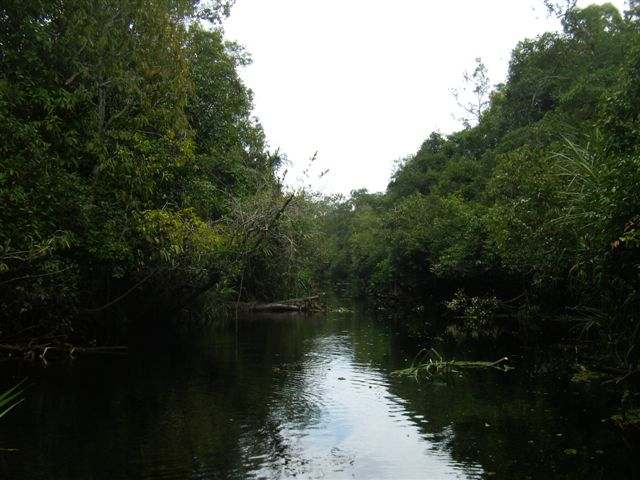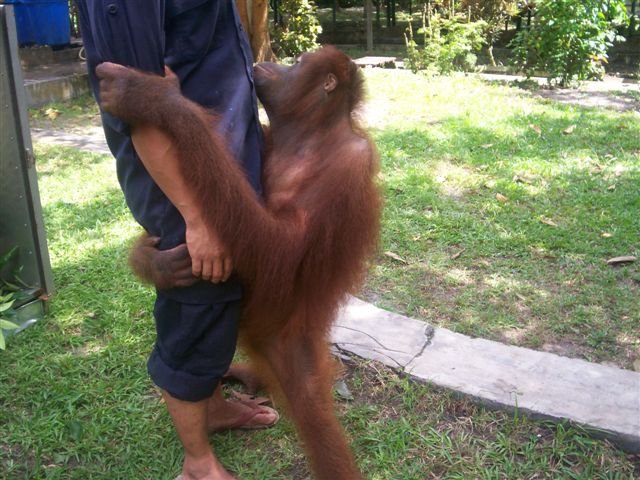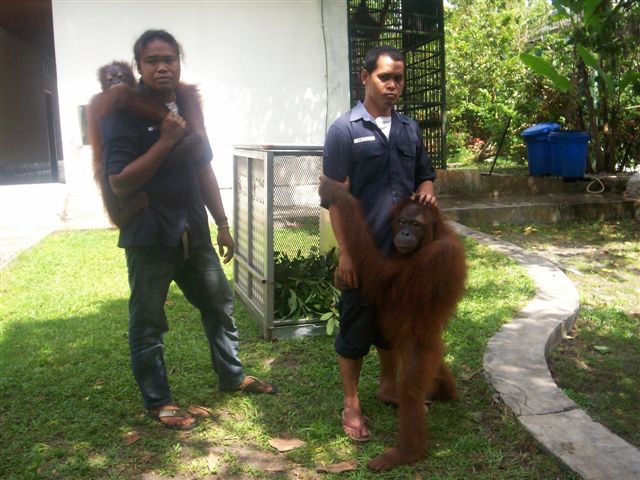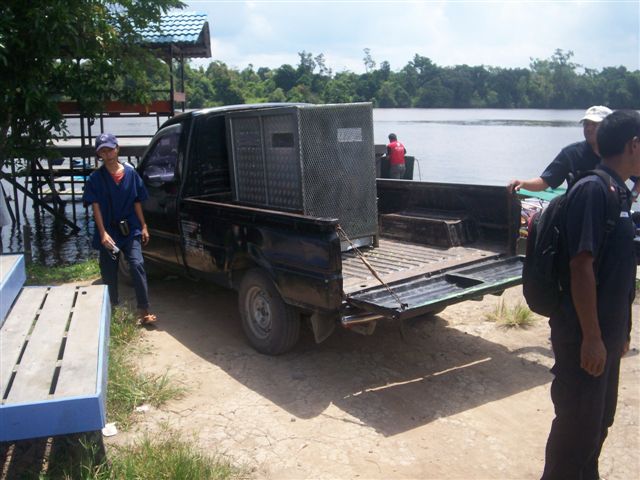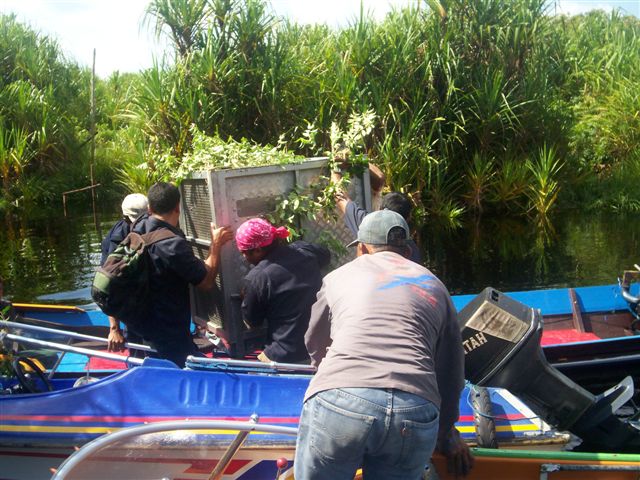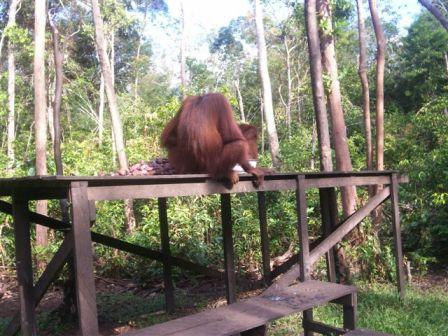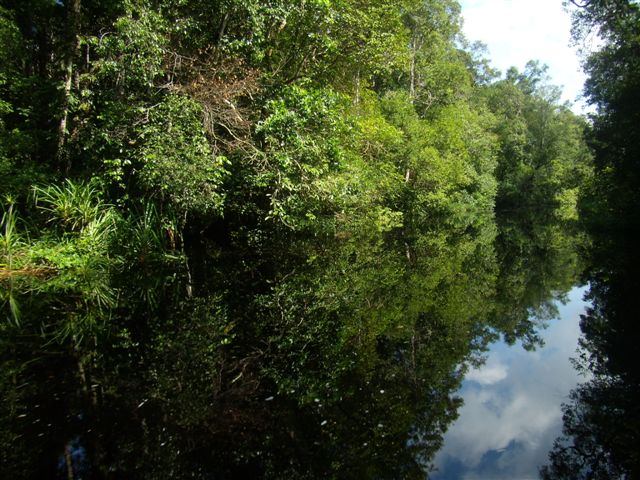Have you ever wondered what it’s like to be an orangutan carer? In the depths of Borneo’s forests, our camps support orphaned orangutans on their journeys back into the wild - and it is the carers that are there for every step of the way. In this ‘In Conversation’, we catch up with the carers of latest release Mona.
Clouded leopard cub back in his natural habitat
Last month we blogged about a clouded leopard cub that was rescued at the end of April.

We are happy to tell you he is doing very well. It was touch and go when he was first rescued and we thought he had a problem with his hind legs. The leopard, who is now about 4 months old, is healthy, active and playful and has put on a kilo since he was found. The villagers, who discovered the cub named him Bombom and we have kept that name as it seems to suit him.
Pak Tigor, the manager of our activities in the Lamandau River Wildlife Reserve, arranged to have a temporary enclosure built for the cub. It is at Camp Gemini where we also have a small vet clinic.
Above and below - Bombom, being transferred to the Lamandau River Wildlife Reserve by speedboat
The enclosure not only gives him space to play but also allows him to get re-united with his natural surroundings. As soon as Bombom was in his enclosure he ran about and climbed all over it. Clouded leopards are thought to be predominantly nocturnal and so a member of the camp's staff has been assigned to keep an eye on him at night.
Photos above and below - Bombom in his new temporary enclosure
Photo above - a playful Bombom
We hope to bring you more news on Bombom soon but in the meantime please consider a donation to support our vital work in Borneo.
Thank you,
Orangutan Foundation
Endangered crocodile species kills local man
I am afraid orangutans won’t feature in this post. Unfortunately, I am writing about something rather sombre. On the 31st December a local man was killed and eaten by a large crocodile. A group of people went out the same night to look for the man and the crocodile but found neither. The next day they called on a pawang or shaman who has the ability to call crocodiles. He worked his magic and within 17 hours of the attack the crocodile was caught and killed; it was almost 5m long and must have been over 50 years old. Inside were the remains of the man.
The Malaysian False Gharial (Tomistoma schlegeli) that killed and ate a local man.
What makes this interesting, as well as tragic, is the crocodile was a Malaysian False Gharial (Tomistoma schlegeli). You may remember last year (A VERY RARE CROCODILE), Rene Bonke was out here studying them. They are one of the crocodile species never reported to have attacked people. Because of this, we need to write up the case. Devis, Pondok Ambung Manager, has been leading the investigation and yesterday we went out to look at the site where the attack occurred.
It isn't surprising Tomistoma kill people. What surprised me was the river where the attack happened. It was an ordinary, peaceful, black-water creek, not 15 minutes upstream from town. It was identical to literally dozens of such rivers that I have seen, been up, even waded across. Never once did it occur to me that such a large Tomistoma might live there. They are an endangered species and you rarely see them.
Being in that place, where I knew someone had died, gave me pause. But behind that was a wonder; a wonder that in this era of chainsaws, speedboats and wanton habitat destruction, an animal of such size could have survived for so long.
For more information about Tomistoma please visit Tomistoma Task Force
More orangutans returned to the wild.
Wow Kusasi certainly proved popular! Thank you for all the positive comments and nice to hear from you again Brigitta. If people want to see the film "Kusasi from Orphan to King" I understand it can be bought on-line from PBS.
The other week I wrote that July was Pondok Ambung, our Tropical Forest Research Station’s, "month". Certainly, the research activities there dominated my time, but that does not mean everything else stopped. In fact, four more orangutans were released from the Orangutan Care Centre & Quarantine into the Lamandau Wildlife Reserve.
I now have a bit of time to tell you about them. Biruté Galdikas supervised the releases with Tigor, the Manager of the five release camps. On 28 July, the adult female Sasha was released along with her adopted daughter Monica. Though Monica was no longer an infant, it is always good to see these adoptions work; no matter how competent the staff at the Care Centre are, obviously a female orangutan is the best possible mother for youngster.
The second release on 4 August was a bit more traumatic. The orangutans, Ucok and Lori, were OK, but the people had some problems! The orangutans were moved out of the Care Centre in the morning, to avoid them travelling in the heat of the day and were carried in a kelotok (a traditional boat a bit like a motorized canoe). Biruté, Tigor and other staff travelled up later in speedboats. Or at least that was the plan; low water levels meant the speedboats could not get up. They lost two propellers and cracked the hull of one of the boats after colliding with submerged logs. Eventually, the kelotok had to come back for them.
The pictures below show the release from the Care Centre to Camp Rasak and then freedom, once again, in the wild.
Monica
Monica and Sasha leaving the OCCQ
These photos show the orangutans being moved from the Care Centre, into the kelotok, then having a few minutes peace on the feeding platform before some other interested orangutans came for a nose.
All the photo's were taken by Uduk, Tigor's deputy, on a camera recently donated to the Orangutan Foundation at our Members and Supporter's Evening in London, in July.
Orangutans and Crocodiles
Hello again, sorry for the silence but I have just had another fantastic week in Tanjung Puting National Park. Actually, on Monday I was in Lamandau, on a peat-lands survey, but I was still out of the office and in the forest, which made for a good day!

In case you're wondering where these places I keep mentioning are, here's a map (Pangkalanbun is where our office is).
At Pondok Ambung I caught up with René, the German crocodile researcher, and then spent a wonderful couple of days at Camp Leakey. There were orangutans everywhere! What was great was seeing some unusual things. Foremost on that list was food sharing between two adult females.
Above and below, Rani and Riga - sharing food
Young orangutans will often sample what their mothers are eating. This is part of the learning process; finding out what is good to eat. However, on Wednesday, I watched two adult orangutans Rani and her daughter Riga sharing food. What made this doubly interesting is that it was Riga who was giving food to her mother. There may be some biological reason for this – Rani’s three year old son is obviously Riga’s half-brother but that seems a stretch. Normally, the genetic drivers of caring-behaviour are down the generations, not up them. This could have been a case of dominance; the older female forcing the younger one to submit. However, it is also quite likely that it was a simple act of altruism: Riga had enough to eat so was happy to share with her mother.
The final excitement of the week was finding a dead and half-eaten crocodile. We reported this to René who examined the carcass. He estimated it to have been around three metres in length and was killed in a fight with another crocodile. Almost certainly the other crocodile was bigger.
Sekonyer River, TPNP
Having just bathed in that river it was kind of sobering to know there was a bigger crocodile out there…..
As always thanks for your comments, questions and support of our work. Maciej G, thank you very much for your $50 donation at the end of June. Will try and post again soon - the daily powercuts aren't making it easy!











